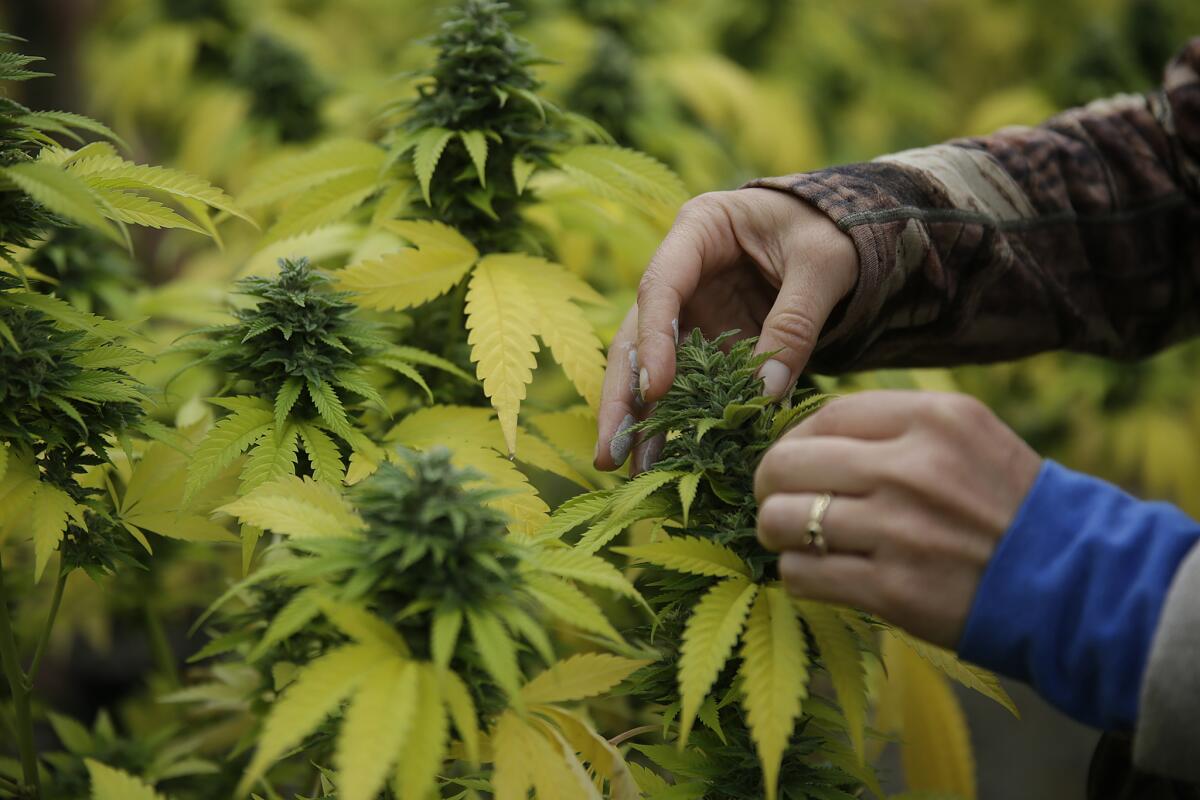Get Big Agriculture out of cannabis farming in California

- Share via
California cannabis farmers are at a crossroads. Will cannabis go the way of Big Agriculture, or can we develop an industry that supports a multitude of farmers, communities and the environment?
The path that agriculture in the United States took has resulted in a highly consolidated industry that is debt-financed, built on underpaid labor, and dependent on exemptions to environmental protections, such as the Clean Water Act. The result? Declining rural populations with lower life expectancies, higher rates of poverty, and a mode of agriculture that drives climate change and biodiversity loss.
Rarely do we get a chance to construct an agricultural system anew. With cannabis, California has a chance to create an alternate model as cannabis prohibition crumbles nationally and worldwide. Can we do things differently this time?
Prohibition blessed us with an unintended outcome — an agricultural sector consisting of small farms. When passed in 2016, Proposition 64 explicitly aimed to build on and support “small and medium sized businesses,” which would be the backbone of the cannabis cultivation sector. As research shows, agriculture sectors that have numerous small farmers are better able to sustain rural communities and healthy environments, particularly when farmers actively participate in policy making, stewardship and community life.
Small cannabis farming, however, is being undermined. Although Californians voted to give smaller-sized farms five years to establish themselves before bigger farms were permitted, the state undercut this by allowing a single grower to “stack,” or obtain, multiple small-farm permits, a loophole that effectively allows larger operations to get in the game early.
To survive, farms are predictably ballooning in size. Research from UC Berkeley’s Cannabis Research Center has found that larger farms pressure all farms to get bigger, go underground or get out. Our research also shows that small farms are less likely to acquire permits.
These farmers now confront a make or break moment. Faced with stringent regulatory requirements that can cost tens or even hundreds of thousands of dollars, smaller producers are becoming indebted and struggling to stay afloat until they can finally turn a profit. Maybe some will find a competitive edge. But under current conditions, many, if not most, will drop out of state regulatory programs and many more will never enter at all.
If we want to ensure that small farmers become legal and diminish the allure of the underground market, we could prohibit the practice of permit stacking and cancel the issuance of large farm permits in 2023 as specified in state law. If coupled with minimum prices set by the state government, as Beau Kilmer of RAND suggests, we could ensure support for small farmers, farmworkers and environmental stewardship, especially if production costs begin to fall.
Short of such reforms, other approaches can help. For example, small-scale, genetically diversified farming would be encouraged if cannabis appellations currently being planned feature and value local environmental characteristics. Producer cooperatives could collectivize costs, information and resources. The state could provide tax incentives (or payments) to farmers for ecosystem services, like carbon sequestration and watershed protection, which could benefit California’s common resources.
Programs designed for socially disadvantaged and minority farmers in rural and urban communities could alleviate regulatory burdens, reduce compliance costs and help farmers navigate changing rules and unclear information, which are two of the primary barriers to compliance. The governor’s proposal to streamline cannabis licensing would also help.
If we do nothing to buttress the position of small farmers now, eventually the price of cannabis will collapse, the industry will consolidate, and we will re-create the conditions of nearly every other agricultural sector in the U.S. Small farmers will disappear and the remaining producers will become dependent on financed debt, resulting in downward pressure on wages, working conditions and environmental protections.
California has acknowledged that cannabis criminalization was wrong and has established community reinvestment and equity funds to help communities damaged by those drug policies. Yet prohibition continues in the counties and cities that ban cannabis cultivation or otherwise exclude farmers through exceptionally stringent regulations and enforcement regimes.
After a century of criminalization, it’s incumbent on the state to help producers fully transition to serving legal markets. This is not only ethically responsible, it is also effective policy that would entice farmers away from the underground economy and rebuild broken trust.
Legalization was only a first step. Now we need to decide what kind of agricultural, environmental and societal future we actually want post-legalization.
Michael Polson is an anthropologist and postdoctoral fellow in the Department of Environmental Science, Policy and Management at UC Berkeley. He has been researching cannabis in Northern California, most recently with members of UC Berkeley’s Cannabis Research Center.
More to Read
A cure for the common opinion
Get thought-provoking perspectives with our weekly newsletter.
You may occasionally receive promotional content from the Los Angeles Times.









